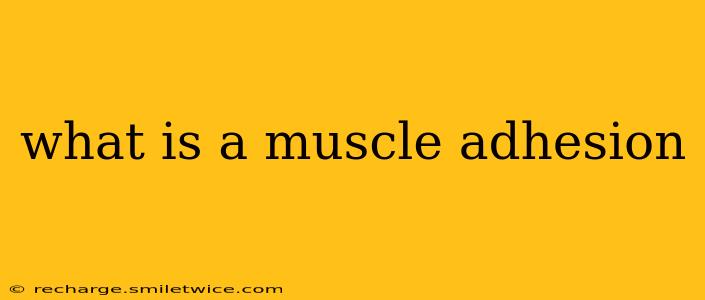Muscle adhesions, also known as myofascial adhesions, are bands of tough, fibrous tissue that form between muscle fibers. These adhesions restrict normal muscle movement, leading to pain, stiffness, and limited range of motion. Instead of gliding smoothly past each other, the muscle fibers become stuck together, creating knots or trigger points. Understanding what causes them and how to treat them is crucial for maintaining musculoskeletal health.
What causes muscle adhesions?
Several factors can contribute to the formation of muscle adhesions. These include:
- Muscle injuries: Tears in muscle tissue, whether from acute trauma (like a strain or sprain) or repetitive micro-tears from overuse, can trigger the body's healing response. This response involves the formation of scar tissue, which can lead to adhesions if not properly managed.
- Inflammation: Chronic inflammation in muscles, often caused by conditions like fibromyalgia or autoimmune diseases, can contribute to the development of adhesions. The inflammatory process damages muscle tissue, leading to scar tissue formation and adhesion.
- Poor posture: Maintaining poor posture for extended periods puts sustained stress on specific muscle groups. This can lead to muscle fatigue, micro-tears, and ultimately, the formation of adhesions. Think about how hunching over a computer all day might affect your back muscles.
- Dehydration: Dehydration can impact muscle elasticity and increase the risk of muscle injury and adhesion formation. Water is essential for healthy muscle function.
- Lack of movement/Inactivity: Prolonged periods of inactivity can lead to muscle stiffness and reduced blood flow, making muscles more prone to adhesions.
- Stress: Chronic stress can contribute to muscle tension and the formation of adhesions. This is often seen in areas like the neck and shoulders.
What are the symptoms of muscle adhesions?
The symptoms of muscle adhesions can vary depending on the location and severity of the adhesions. Common symptoms include:
- Localized pain: A sharp, stabbing pain or a dull, aching pain in the affected area.
- Muscle stiffness: Difficulty moving the affected muscle or joint.
- Limited range of motion: Inability to move the affected area through its full range of motion.
- Muscle spasms: Involuntary muscle contractions.
- Trigger points: Hypersensitive points in the muscle that cause pain when pressed.
How are muscle adhesions diagnosed?
Diagnosing muscle adhesions often involves a physical examination. Your doctor or physical therapist will assess your range of motion, palpate (feel) the affected muscles for knots or trigger points, and review your medical history. Imaging tests, like ultrasound or MRI, are usually not necessary unless other conditions are suspected.
How are muscle adhesions treated?
Treatment for muscle adhesions focuses on breaking up the adhesions and restoring normal muscle function. Common treatments include:
- Massage therapy: Different massage techniques can help to break up adhesions and improve blood flow to the affected area.
- Myofascial release: A specialized type of massage that focuses on releasing tension in the fascia (the connective tissue surrounding muscles).
- Stretching exercises: Regular stretching can help to lengthen and loosen tight muscles, preventing adhesion formation.
- Foam rolling: Self-massage using a foam roller can help to break up adhesions and improve muscle flexibility.
- Heat and ice therapy: Applying heat or ice can help to reduce pain and inflammation.
- Exercise and movement: Maintaining regular physical activity is key to preventing adhesions and promoting healthy muscle function.
Can muscle adhesions be prevented?
Yes, you can significantly reduce your risk of developing muscle adhesions by adopting healthy lifestyle habits. These include:
- Regular exercise and stretching: Engage in activities that promote flexibility and strength.
- Maintaining good posture: Be mindful of your posture throughout the day.
- Staying hydrated: Drink plenty of water to maintain muscle elasticity.
- Managing stress: Employ relaxation techniques like yoga or meditation.
- Proper warm-up and cool-down: Always warm up before exercise and cool down afterward.
What is the difference between muscle adhesions and knots?
The terms "muscle adhesions" and "knots" are often used interchangeably, but there's a subtle difference. "Knots" generally refer to the palpable lumps or trigger points felt in the muscle, which are symptoms of the underlying issue—the adhesion. The adhesion itself is the microscopic binding of muscle fibers. The knot is a more easily recognizable physical manifestation of the adhesion.
Are muscle adhesions serious?
While most muscle adhesions are not serious and can be treated effectively, in severe cases, they can significantly impact daily life, causing chronic pain and limiting mobility. Prompt treatment is crucial to prevent the condition from worsening.
This information is for general knowledge and does not constitute medical advice. Always consult with a healthcare professional for any health concerns or before starting any new treatment plan.
